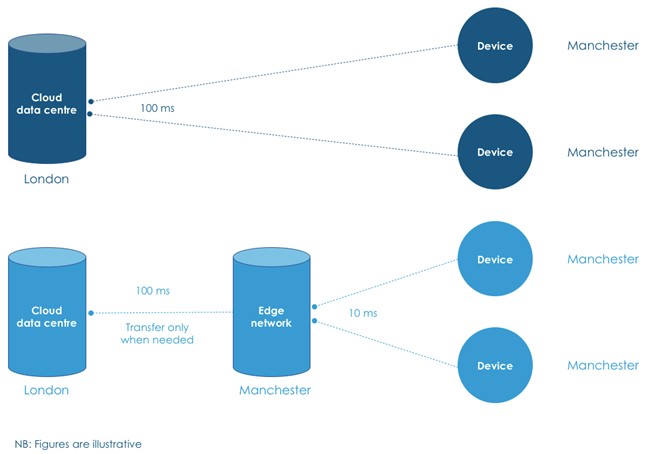Edge computing - capturing, processing, and analysing dynamic data near where it’s both created and needed
Edge computing is more about location than technology; if speed matters, then so does distance. With origins in the 1990s web and video delivery networks that distributed content from servers close to users, edge optimises internet devices and web applications by bringing computing closer to the source of the data. Rather than sending all data collected by IoT sensors directly to the Cloud, an actual device within the local network processes the relevant information you need.

Benefits
Edge computing creates new and improved ways for industrial and enterprise-level organisations to maximise operational efficiency, improve performance and safety, and automate all core business processes. It should be seen as complementary to Cloud services, as it has different benefits:
Better data management. Relocating data that is critical to business performance means data is logically separated to where it’s needed most, it forces a data review/clean-up, and encourages real-time data processing that allows you to respond faster and more effectively to business changes.
Lower costs. Edge offers a cost-effective route to scalability by combining co-location services with regional edge computing data centres. Companies can target a specific market without investing in expensive infrastructure expansion, and growth costs are eased as each new device added doesn’t impose substantial bandwidth demands. Less data is being transported around your system, so storage requirements/costs are reduced, and connections over shorter distances help lower them even further.
Reliable, uninterrupted connection. Edge ensures ‘always on’ availability and applications can be used effectively in remote locations. With data transfer happening over shorter connection lines, reliability is organically improved. Transfers happen faster and with reduced interruptions meaning throughput increases and latency decreases.
Improved security practices. Edge computing allows you to remove sensitive data at source rather than sending it to a centralised data warehouse. Lower transfer rates of sensitive data mean better data security.
Centralised Cloud computing architecture makes it especially vulnerable to power outages and Distributed denial of service (DDoS) attacks (where an existing network resource is overwhelmed with traffic from other compromised resources within the network). Edge computing distributes processing, storage, and applications across a wide range of devices and data centres, which makes it difficult for any single disruption to take down the entire network.
Although edge creates an increased cyberattack surface by locating computing resources closer to data sources and IoT edge devices, it’s easier to implement security protocols to seal off any weak points without shutting down the entire network.
The ownership of the data collected shifts from service providers to end-users, and it provides better data sovereignty/geographical legislation (GAIA-X vs. the US CLOUD Act). Aitemology® NED Paul Kearney gives an example: “I work with a MedTech company that is proud to shout about their patients’ personal data being held on a renowned database server in a country of their choice. It’s still in the Cloud but somewhere a bit ‘edgier’ than out in the ether, which makes their GDPR managers happy.”
It’s worth noting that security challenges are a bit different with edge as data travels between different distributed nodes connected through the internet and it requires special encryption mechanisms independent of the Cloud.
Having the edge
Organisations need to think of ‘edge’ as an extension of Cloud rather than a replacement. Dave McCarthy, research director in IDC’s worldwide infrastructure practice focusing on edge strategies says: “A centralised approach to infrastructure has limitations. Instead, enterprises are now looking at edge computing as a way to distribute workloads to locations where they run best such as remote and branch offices, or industry-specific locations like factories, warehouses, hospitals, and retail stores.”
According to Gartner, less than 10% of enterprise-generated data is created and processed at the edge right now, but they predict this will grow to 75% by 2025. IDC predicts that by 2023, more than half of new enterprise IT infrastructure deployed will be at the edge rather than corporate data centres, and the number of apps at the edge will increase 800% by 2024.
Author:
Aitemology® is the creator of a unique methodology (aitemology®) that forms the basis of the digital and business transformation Plug and Playbook series (Cloud, Change, Consult etc.). Consisting of a ‘how to’ primer underpinned by a large number of specific/dedicated aitems® (policies, processes, technical products, reports, templates), organisations are able to follow their chosen transformation process step by step from start to finish (including all technical and non-technical elements) with convenience, clarity and control.
aitemology.com

Laura Foster
Laura is techUK’s Associate Director for Technology and Innovation.


